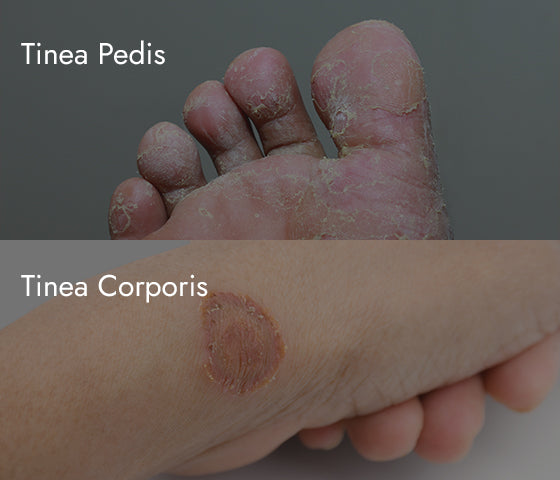What is an athlete’s foot?
Tinea pedis, more commonly known as athlete’s foot, is a highly contagious fungal infection that affects the feet. Fungi, known as dermatophytes, invade and then reproduce on the feet, causing symptoms most commonly between the toes and, in less common cases, on the soles and sides of the feet too. [1]
These dermatophytes consume keratin, a protein that is found in the hair, nails, and the outer layer of the skin. [2] The dermatophytes that cause athlete’s foot like to live in warm, moist conditions, so sweaty feet or a moist environment inside shoes and socks, is particularly ideal for them to thrive in.
Though an athlete’s foot is usually relatively harmless, it can - in rare cases - lead to more extreme issues. It is also an uncomfortable condition and one that is highly contagious, so it is important to treat it as soon as possible to stop it from worsening or spreading. Untreated tinea pedis may also lead to other fungal conditions, including tinea unguium (also known as a fungal nail infection).
Symptoms of athlete’s foot
There are a range of symptoms of an athlete’s foot; some of these are purely aesthetic, but the condition can cause sores, itching, and discomfort, too. Most commonly, symptoms of the fungal infection are apparent in between the toes. This is especially the case in its early stages. Here, you may find whitening, peeling, or broken skin, as well as soreness, redness, or itchiness between the toes. The peeling may spread to the underside of the toes, and the affected skin could be either dry and scaly or damp, with the peeling skin softer than usual. [3]
When it occurs on the sides of the feet, the athlete’s foot may look like a redness or cracking of the skin. Sometimes, this is said to look as if the sufferer is wearing a red or pink slipper. In the rarest cases, tinea pedis may present as sores or pustules on the soles of the feet; these can be extremely itchy, painful, and uncomfortable. An athlete’s foot may also contribute to the presence or worsening of an unpleasant foot odor.
What causes athlete’s foot?
In the last half-century, there has been a significant increase in cases of tinea pedis. Nowadays, in fact, athlete’s foot is the second most common skin condition in the US, after acne. [4] While this could just be put down to an increase in people seeking treatment, it is also thought to be likely that the increase in cases is due to the demands of our daily lives and our hobbies too. [5]
For example, it is more common that we spend our days wearing uncomfortable, enclosed shoes for work. If we find ourselves with regularly sweaty and damp feet, for example, from being on our feet in enclosed shoes for long periods, we may be more prone to developing athlete’s foot. This is because these are the perfect conditions for the dermatophytes to spread and multiply. As tinea pedis is highly contagious, if we have a case of athlete’s foot of our own and share a bed, towels, or clothing with others, they are likely to develop it, too.
If, in our leisure time, we take part in sports and use public facilities like swimming pools, gyms, locker rooms, and communal showers, we may also encounter athlete’s foot more readily. [6] The surfaces we walk on here are shared between lots of people and are often moist and warm. As a result, they are one of the main places where the highly transmissible and prevalent fungal infection is spread. Dermatophytes can survive on these surfaces for long periods of time, so if you are walking barefoot where someone with athlete’s foot has also walked, you are likely to collect the dermatophytes and contract a case of athlete’s foot of your own.
Additionally, tinea pedis is particularly common in people who have diabetes or other conditions in which the immune system is weakened. [7]Age may be a factor, too, with the elderly and people who are obese more likely to develop a case of tinea pedis. [8] Though men are slightly more likely to develop a case of athlete’s foot than women, one thing is clear: everyone is at risk of contracting tinea pedis.
As athlete’s foot is so prevalent, it is something that most of us will suffer from at some point in our lives. While there are plenty of measures we can take to reduce our risk of infection, it is also important that we treat cases of tinea pedis efficiently and effectively to reduce our own risk and that of others, too.
How to treat athlete’s foot
Because athlete’s foot is a fungal infection, it can only be treated using antifungal products that eliminate the dermatophytes from the skin. Though there are plenty of athlete’s foot treatments on the market, many of these over-the-counter products use harsh chemicals that may have unpleasant and unwanted side effects. Naturasil offers a range of homeopathic treatments that obtain powerful results by making use of the healing properties of all-natural products. Because our ingredients are natural, the products are suitable for use on your skin and will heal your athlete’s foot safely and effectively.
Our Athlete’s Foot Treatment Value Pack includes two powerful, natural products to help you effectively combat tinea pedis while soothing the discomfort that the condition causes. Our Sulfur Lavender Soap is the ideal product for cleansing your feet - both during your athlete’s foot infection and afterward. Washing your feet twice a day with the soap allows the natural antifungal properties of sulfur to target the dermatophytes, eliminating them - along with any other bacteria and impurities that may be causing related conditions, including foot odor. The lavender keeps your feet fresh while soothing and calming you and your skin and promoting healing.
Enriched with antifungal sulfur compounds, Naturasil Athlete’s Foot Oil acts fast to eliminate fungus when applied topically to the affected area. Our foot oil formula also makes use of the healing power of tea tree oil, which, due to its antiseptic properties, is clinically proven in the treatment of athlete’s foot. [9] The athlete’s foot oil should be applied two to three times per day until all symptoms have disappeared, to ensure that the fungal infection is completely eradicated.
As athlete’s foot is highly transferable, it also has a very high recurrence rate. To prevent recurrent cases of tinea pedis, you should make sure—once your current case has cleared up—that your shoes, socks, towels, and all foot care products, like nail clippers and scissors, are thoroughly disinfected. Wear flip-flops when walking on communal surfaces like locker room floors, and swap sweaty socks regularly. In addition, ensure that your feet are completely dry after washing and before you put on your socks and shoes, and exercise caution if you know that someone in your household has a current case of the condition. Do not share towels, and try to avoid walking barefoot.
As our products are all-natural and suitable for long-term use, consider adding our Sulfur Lavender Soap to your daily foot care routine. Keeping your feet free from bacteria and fungi, regular use of our soap offers long-lasting protection against tinea pedis, fungal nail infections, foot odor, and other related conditions.
[1] Ilkit, M. and Durdu, M. (2014). ‘Tinea pedis: The etiology and global epidemiology of a common fungal infection.’ Critical Reviews in Microbiology, 41(3), 374-388.
[2] Nowicka, D. and Nawrot, U. (2021). ‘Tinea pedis - an embarrassing problem for health and beauty: a narrative review.’ Mycoses, 64(10), 1140-1150.
[3] Al Hasan, M., Fitzgerald, S.W., Saoudian, M., and Krishnaswamy, G. (2004). ‘Dermatology for the practicing allergist: tinea pedis and its complications.’ Clinical and Molecular Allergy, 2.
[4] Al Hasan, et al., 2004.
[5] Ilkit and Durdu, 2014.
[6] Ibid.
[7] Al Hasan, et al., 2004.
[8] Ibid.
[9] Tong, M.M., Altman, P.M., and Barnetson, R.S.C. (1992). ‘Tea tree oil in the treatment of tinea pedis.’ Australasian Journal of Dermatology, 33(3), 145-149.






